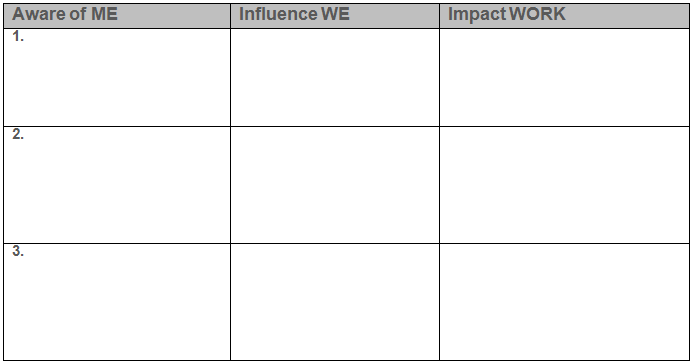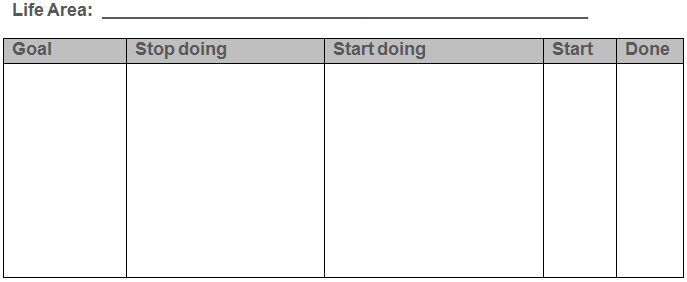STEP 6:
Choose one life area that you wish to set a goal for.
After evaluating what you have listed you may have gained insight into other aspects and may choose to take on a whole other life area. The purpose of the exercise is to assist you to clarify your thoughts and gain a glimpse of the impact of the area that you wish to pursue. Thus the next step where you choose which area you wish to set a goal in, is not necessarily a natural flow of deduction from the previous steps. It remains your choice to decide which area you wish to pursue at any point as you gained clarification from steps 1 – 5.
Set your goal:
| Once we have set a goal we need to prepare “ME” / “self” for the journey. In this respect steps 7 – 9 addresses setting you up for success by analysing and evaluation the likely outplay of the goal pursuit in accordance with how well you know yourself. |
STEP 7:
Identify your areas of fear
Our decisions play out affectively on our thoughts and emotions bearing fear and excitement. Too much fear debilitates us and keeps us from moving; too much excitement leads to a typical situation where we find ourselves crossing the fine line between enthusiasm and stupidity for we do not acknowledge the risks associated with our actions. Thus we need a healthy dose of fear to identify the risks involved and a healthy dose of excitement to motivate us to move.
Appreciate your time line perspectives
Our frame of reference determine our timeline perspectives as seen in our past (from pre-birth to the past second of our lives is past tense), present (now this second) and future (then next second) perspectives.
Negative emotions (which cultivate limiting beliefs such as I am not good enough) such as regret and guilt (i.e. that could have been through experiences such as trauma and rejection) can only be found in our past perspective. Fear is normally associated with the future. A belief such as “I am not good enough” may taint ones perspective of life and one’s belief of possibilities and personal capabilities.
From a “protecting self-point of view” we make present day decisions through merging our past guilt and regret for example with future expectations of fear which results in us not making realistic and healthy present tense decisions. By merging past and future perspectives we do not acknowledge our current realities, we are not conscious of our options as our judgment is clouded by guilt and fear for example (not living consciously) and therefore we limit our outcome. Our thought world is controlled by past (things I cannot change) and present (things that have not happened yet) perspectives.
Present tense decisions may be informed by past experience as a guide to identify possible risk and informed by possible future exceptions of fear once again to inform risking taking. However my present tense decisions need to be FORMED by my current possibilities and options.
a.)What do I fear (past and future perspective)?
Before we attempt anything we need to face our fears that may crop up as we progress toward meeting a goal or achieving a task. There are primary areas in our life that bring about fear. Evaluate how your chosen life area and related goal / s may relate to these fears.
b.)What are the constraints (past and future perspective) to personal growth I may encounter?
| c.)Before I attempt this goal what must I stop doing (present perspective) that is keeping me from progressing in this life area that I have selected and the related Goal I have set? |
d.) Before I attempt this goal what must I start doing (future perspective) that is keeping me from progressing in this life area that I have selected and the related goal I have set?
STEP 8:
Note your life area of change desired and list your SMART goal in relation to what you must stop and start doing to attain the goal. Note your kick off and achieved date once you have accomplished your goal.
This step reaffirms the result of your thought process which is the life area you have chosen to pursue a goal in as well as the goal articulated to serve as your beacon during your personal development journey.
STEP 9:
Choose your accountability partner.
Growing by yourself you can be good, growing with someone you can be great, John C Maxwell.
Your accountably partner should be someone that is available, committed to you and your success, that buys into your goal / dream, someone that will tell you straight and someone that you can talk to during your journey, someone that will balance feedback between when to be supportive if you have not met a milestone on your journey to achieve your goal and when to give you straight talk when they believe you may have lost focus or hope of achieving your goal. It must be someone that you respect and that you will be willing to listen to their counsel.
a.)Share your life area, goal, stop and start doing, kick off and end date with your accountability partner.
b.)Discuss your fears and the possible constraints to personal growth as you see it may play out on your development journey to achieve your goal.
Contact details
Twanette Fourie: Behavioural Intelligence Specialist: Coach/ Consultant / Trainer / Speaker
Cellular No: 072 298 0045 corporatetraining@telkomsa.net
Blog: TwanetteFourie@wordpress.com Twitter: @FourieTwanette
To attempt and to fail is like losing your grip momentarily. Not to try at all because of fear of failing, is like losing yourself forever. Soren A Kierkegaard


